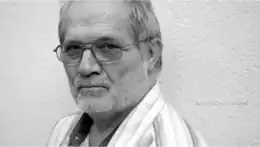| Lady Sarashina | |
|---|---|
| Opera by Péter Eötvös | |
 The composer in Gáspár Stekovics's photo | |
| Librettist | Mari Mezei |
| Based on | As I crossed a Bridge of Dreams |
| Premiere | |
Lady Sarashina is an opera in nine tableaux by Hungarian composer Péter Eötvös to a libretto by Mari Mezei, based on As I crossed a Bridge of Dreams, fragments of an 11th-century diary (Japan, 1008) by Takasue's daughter, also known as Lady Sarashina. It premiered on 4 March 2008 at the Opéra National de Lyon. The opera is the result of a commission by the opera in Lyon; it was broadcast in full on France Musique on 27 September 2008.
Libretto
Lady Sarashina lived in Japan in the eleventh century, a time of high civilization where Japanese women held an essential role in social, economic and cultural life. She is the author of a classic piece in Japanese literature, The Journal of Sarashina. In her diary, she writes about her love of Japanese nature and landscapes, describes the sites she visits, the pilgrimages, dreams and monologues about life and death. In the opera, Lady Sarashina narrates her life. All the other roles are portrayed by three other singers, the Vocal Trio.[1]
Roles
| Role | Voice type | Premiere cast, 4 March 2008 Conductor: Peter Eötvös[2] |
|---|---|---|
| Lady Sarashina | soprano | Mireille Delunsch |
| Trio vocal: Le Garde, Le Bouffon, Le Messager, Le Père, Le Chat, Le Bonze, Le Gentilhomme | baritone | Peter Bording |
| Trio vocal: La Princesse, La Jeune Lady, Une dame du rêve | soprano | Ilse Eerens |
| Trio vocal: L'Impératrice, La Mère, La Sœur, Une dame du rêve, La Dame d'honneur | mezzo-soprano | Salome Kammer |
| Orchestra | Orchestre de l'Opéra de Lyon | |
| Director | Ushio Amagatsu | |
| Set | Natsuyuki Nakanishi | |
| Costumes | Masatomo Ota | |
| Lighting design | Yukiko Yoshimoto | |
The staging was a co-production with the Théâtre national de l'opéra-comique, where it was staged in February 2009.[3] In April 2013, the same production was mounted by the Polish National Opera in Teatr Wielki, Warsaw.[4]
Instrumentation
The instrumentation calls for: 2 fl (both + Piccolo, second + altfl.), 1 ob (+ Eng.horn), 3 clar. (third + basscl.), 2 bassoon (second + contrabassoon), 1 sax (S-A-T-Bar), Winds: 3 - 2- 3- 1, 2 percussion, 1 harp, 1 sampler keyboard Strings: 6 - 5 - 4 - 3 - 2[5]
Critical reception
In 2008, the opera received the prestigious Prix du Syndicat de la critique for Best Musical Creation.[6] The world premiere drew wide international attention from the press. Reviews ranged from favorable to triumphant.[7] [8] [9] [10]
References
- ↑ "Lady Sarashina". Opéra National de Lyon.
- ↑ "Fiche spectacle Lady Sarashina". Opéra National de Lyon.
- ↑ "Fiche spectacle Lady Sarashina". Théâtre national de l'opéra-comique.
- ↑ "Lady Sarashina". Polish National Opera.
- ↑ "Lady Sarashina (2007)". Peter Eötvös.
- ↑ "MEILLEURE CRÉATION MUSICALE: Lady Sarashina". Prix du Syndicat de la critique. Archived from the original on 2016-03-13. Retrieved 2013-03-27.
- ↑ "FT.com, Arts". Financial Times.
- ↑ "L'ÉPURE DU RÊVE". ResMusica. 11 March 2008.
- ↑ "Het verdriet van een Japanse hofdame". De Standaard.
- ↑ "Le journal nippon d'Eötvös". La Libre Belgique. 11 March 2008.